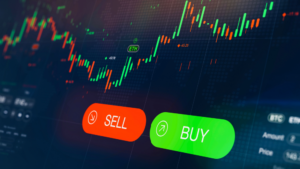The story this morning is clearly the stunning rise in the price of Alphabet (GOOG, GOOGL). It’s higher for the correct reasons: solid earnings and returning money to shareholders. Enthusiasm about artificial intelligence certainly played a role, but a manufacturer of boring widgets would rally if it could show revenues rising 15%, profits up 36% (both soundly beating estimates), initiate a dividend, and buy back $70 billion in shares using free cash flow.
We noted yesterday that we saw increased risk aversion in both GOOG and Microsoft (MSFT). The latter is also up on solid earnings, though not nearly as spectacularly as the former. The takeaway from the options market activity ahead of major tech earnings this week is that options traders were excellent contrary indicators. We noted on Tuesday that we saw unusual levels of risk aversion ahead of Tesla’s (TSLA) earnings, and that stock subsequently rallied by double digits in spite of missing on a wide range of metrics. On Wednesday, we saw only slight risk aversion ahead of Meta Platforms’ (META) earnings, and that proved far from sufficient. And of course, yesterday’s drop in META and early dip in the broad market got traders nervous about yesterday’s upcoming MSFT and GOOG. No need for nerves, though the increase in implied volatility in GOOG proved to be warranted by today’s pop.
GOOG’s 10% rise gives it a market capitalization of over $2 trillion, joining MSFT, Apple (AAPL), and Nvidia (NVDA) in that exclusive club. But here is the crazy part that is unique to megacap tech stocks: that 10% jump means that the combination of GOOG and GOOGL added about $200 billion to its market capitalization today. For some perspective, that’s roughly the market cap of Disney (DIS) or McDonald’s (MCD).
Perhaps we should start measuring these big moves in terms of MCDs. When META rallied 20% after its Q4 report in February, it added about 1 MCD to its market cap. Yesterday, when it fell -10.5%, it lost about $100 billion, or about half an MCD, or about two Super Micro Computers (SMCI). We can play around with the yardstick, but I hope you get the point. The megacap stocks are so enormous that when they have significant moves, they can swing their market caps in magnitudes of other major companies.
The other item we touched upon yesterday was the bond market’s seemingly perplexing reaction to a significantly weaker than expected Q1 GDP report. The reading of +1.6% was far below both the 2.5% consensus and last quarter’s 3.4%. In theory, bond yields should fall on signs of a weaker economy. But instead, they rose because the Core PCE Price Index rose 3.7% on a quarterly basis, above the 3.4% consensus and last quarter’s 2.0%. Higher than expected prices, combined with weaker than expected economic growth raised fears of stagflation. That is a nasty combination, and certainly unfriendly for markets. A slower economy is a headwind for corporate earnings while the sticky inflation makes it difficult, if not impossible, for central banks to cut rates.
Considering that we came into the year with market expectations for the mutually exclusive combination of a solid economy and several rate cuts, it was encouraging to see stock prices rise as economic health diminished both the need for and likelihood for those cuts. Now we may find ourselves in the opposite situation, which is unfortunately quite possible. Today’s PCE Core Deflator report, the Fed’s preferred inflation measure, eased some, but hardly all of those concerns when the monthly reading showed the expected +0.3% rise. The annual increase was 2.8%, slightly above the +2.7% that was expected, but today’s monthly reading means that when we annualized the most recent three months, a measure that many economists prefer, it shows an increase of +3.6%. For those keeping score, that’s substantially above the Fed’s 2% inflation target.
Next week’s FOMC meeting will give us a better sense of the Federal Reserve’s intentions. As of now, there is almost no expectation for a rate move, while the likelihood for June is down to 12.5% according to Fed Funds futures. A full cut isn’t priced in until November, after the upcoming election. Things have changed in the past few months, but the tone of the equity market mostly has not. Good earnings from key companies can forestall changes in sentiment.
Join The Conversation
If you have a general question, it may already be covered in our FAQs. If you have an account-specific question or concern, please reach out to Client Services.
Leave a Reply
Disclosure: Interactive Brokers
The analysis in this material is provided for information only and is not and should not be construed as an offer to sell or the solicitation of an offer to buy any security. To the extent that this material discusses general market activity, industry or sector trends or other broad-based economic or political conditions, it should not be construed as research or investment advice. To the extent that it includes references to specific securities, commodities, currencies, or other instruments, those references do not constitute a recommendation by IBKR to buy, sell or hold such investments. This material does not and is not intended to take into account the particular financial conditions, investment objectives or requirements of individual customers. Before acting on this material, you should consider whether it is suitable for your particular circumstances and, as necessary, seek professional advice.
The views and opinions expressed herein are those of the author and do not necessarily reflect the views of Interactive Brokers, its affiliates, or its employees.




















Excellent article. Got me thinking. Perhaps Fed Reserve Interest Rates should be determined using AI. There is enough information about the history of the USA economy for a computer to calculate appropriate rates. The Fed has been wrong too many times. The Fed is not apolitical. My studies and calculations over the years indicate that the Fed needs to keep its rate about 2% above the current PCE core. Eventually as inflation drops to 2% (in theory), the neutral rate should be 4%. For now, I would have quit raising at 5.75%. To me, economics is applied mathematics. Computer programming too.
“But here is the crazy part that is unique to megacap tech stocks: that 10% jump means that the combination of GOOG and GOOGL added about $200 billion to its market capitalization today. For some perspective, that’s roughly the market cap of Disney (DIS) or McDonald’s (MCD).
Perhaps we should start measuring these big moves in terms of MCDs. When META rallied 20% after its Q4 report in February, it added about 1 MCD to its market cap. Yesterday, when it fell -10.5%, it lost about $100 billion, or about half an MCD, or about two Super Micro Computers (SMCI).”
All my life (78years) I heard that excess government spending was the primary cause of inflation. If you make the dollar worth-less you pay more for anything. With overspending at 3 Trillion per annum there is no path to 2 percent.
The fed should concern itself with keeping track of banking matters rather than control or fix interest rates. Interest rates should be determined by the free market !